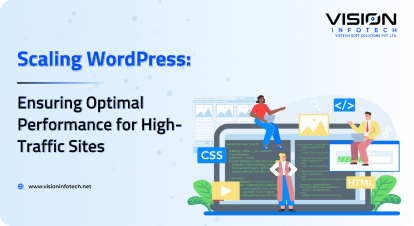Blog
Our blog offers a window into the world of Vision Infotech, where we share expert advice, industry trends, and success stories. Stay informed and inspired with our latest posts.

Scaling WordPress: Ensuring Optimal Performance for High-Traffic Sites
Vision Infotech
July 18, 2023Introduction:
Scaling a WordPress website is crucial for businesses, especially when anticipating high traffic volumes resulting from marketing campaigns, viral content, seasonal events like Black Friday and Cyber Monday, e-learning platforms, ad campaigns, giveaways, and contests. This article will explore the challenges businesses face when scaling WordPress sites and highlight the essential features to consider in scalable WordPress hosting.
Viral Content:
Creating captivating and shareable content can lead to sudden spikes in traffic. To ensure seamless scaling, businesses can implement several strategies. Firstly, they can utilise a content delivery network (CDN) to distribute the content across multiple servers globally. CDN helps in reducing latency and improving page load times, even during high-traffic periods. Additionally, businesses can leverage caching mechanisms such as server-side caching or plugins like WP Rocket to store static versions of pages, reducing the load on the server and improving website performance. By employing these scaling techniques, businesses can accommodate increased traffic without experiencing 404 or 502 errors.
BFCM (Black Friday and Cyber Monday):
Black Friday and Cyber Monday are known for attracting a surge in online shoppers, leading to a significant increase in website traffic. To handle the influx of visitors during these events, businesses can employ various scaling strategies. Firstly, they can opt for scalable WordPress hosting solutions that offer vertical scaling options. Vertical scaling involves increasing the server’s resources, such as CPU, RAM, and storage capacity, to accommodate the growing traffic needs. Load balancing techniques can also be implemented to distribute the traffic across multiple servers, ensuring optimal performance. By adequately scaling their WordPress site, businesses can meet the demands of these seasonal events without compromising user experience.
E-Learning Website:
As online learning continues to gain popularity, e-learning platforms often experience substantial traffic spikes during peak times such as course launches or examination periods. Scaling a WordPress e-learning website involves addressing the increased demand while maintaining site availability and responsiveness. One approach is to utilize scalable WordPress hosting that offers monitoring features. Real-time monitoring allows businesses to track website performance, identify potential bottlenecks, and respond quickly to any performance issues. Additionally, businesses can implement vertical scaling techniques to increase server resources and accommodate the surge in traffic. By combining monitoring, vertical scaling, and other scaling strategies, e-learning websites can ensure seamless user experiences during peak periods.
Ad Campaign:
Running successful ad campaigns can generate a significant increase in traffic to a WordPress site. To scale effectively and handle sudden surges in visitors, businesses need to implement appropriate strategies. One crucial aspect is choosing a scalable WordPress hosting provider that offers flexible vertical scaling options. This allows businesses to increase server resources, such as CPU and RAM, to handle the increased load. Additionally, implementing caching mechanisms and utilising CDNs can improve website performance by reducing server load and improving page load times. By scaling their WordPress site and optimising it for high traffic, businesses can ensure that their ad campaigns drive traffic without compromising website performance.
Giveaways/Contests:
Organising giveaways or contests can attract a considerable amount of traffic to a WordPress site. To handle the increased demand and prevent any interruptions in user engagement, scaling strategies should be employed. Businesses can opt for scalable WordPress hosting that offers vertical scaling options, allowing them to increase server resources based on traffic needs. Additionally, implementing bot protection measures is crucial to reduce strain on the server caused by unwanted bot traffic. Utilising CDNs and caching mechanisms further enhances scalability by improving page load times and reducing server load. By effectively scaling their WordPress site, businesses can successfully manage the traffic generated by giveaways and contests.
WordPress Scalability Challenges:
Plugins and Themes:
Incompatible or poorly coded plugins and themes can hinder the scalability of a WordPress site. To ensure smooth scaling, businesses should carefully select and regularly update their plugins and themes. It is important to choose reliable and optimized plugins that can handle increased traffic volumes efficiently. Regularly updating these components ensures compatibility with the latest WordPress versions and security patches, enabling smooth scaling without compromising website performance.
Server Hardware:
As traffic grows, the server’s hardware capacity may become insufficient, resulting in decreased performance. Scaling server hardware involves upgrading to a more powerful server or employing load-balancing techniques. Upgrading server hardware provides increased processing power, memory, and storage capacity, allowing the server to handle higher traffic volumes effectively. Load balancing involves distributing traffic across multiple servers, reducing the load on individual servers, and ensuring optimal performance even during high-traffic periods.
Bot Traffic:
Unwanted bot traffic can consume server resources and negatively impact website performance, hampering scalability. To address this challenge, implementing effective bot protection measures is essential. These measures can include implementing CAPTCHA challenges, IP blocking, or utilizing advanced bot detection algorithms. By blocking or mitigating bot traffic, businesses can optimize server resources and enhance scalability for legitimate users.
Scalable WordPress Hosting:
Monitoring Feature:
A crucial feature in scalable WordPress hosting is real-time monitoring. It allows businesses to track various performance metrics, such as server load, response times, and traffic patterns. By monitoring these metrics, businesses can identify potential bottlenecks or performance issues and respond proactively to ensure optimal scalability.
Vertical Scaling:
Vertical scaling involves increasing the resources of the server, such as CPU, RAM, and storage, to handle higher traffic volumes. A scalable hosting solution should offer flexible vertical scaling options, allowing businesses to allocate additional resources to accommodate increased demand. This scalability ensures consistent performance during peak traffic periods.
Bot Protection:
A robust bot protection mechanism is vital to safeguard server resources and enhance scalability. Effective bot protection measures can include CAPTCHA challenges, IP blocking, or advanced algorithms that differentiate between bot and human traffic. By implementing strong bot protection, businesses can ensure that server resources are allocated efficiently to genuine users, contributing to enhanced scalability.
Content Delivery Network (CDN):
A CDN is a network of distributed servers that store cached website content. By leveraging a CDN, businesses can distribute website content across multiple servers globally, reducing latency and improving page load times. Integrated CDN services provided by scalable hosting providers enhance scalability by efficiently handling increased traffic and ensuring faster content delivery to users worldwide.
Cache:
Caching mechanisms play a crucial role in improving website performance and scalability. Server-side caching or plugins like WP Rocket store static versions of pages, reducing the load on the server during high-traffic periods. By serving cached content, the server can handle increased traffic more efficiently, resulting in improved scalability and faster page rendering.
Database & Disk Clean:
Regularly optimizing and cleaning the database and disk can significantly impact website performance and scalability. A scalable WordPress hosting solution should offer automated database and disk-cleaning features. These features help eliminate unnecessary data, optimize database queries, and ensure efficient use of storage resources. By keeping the database and disk clean, businesses can enhance site performance and scalability.
By addressing these scaling challenges and selecting a scalable WordPress hosting provider that offers monitoring, vertical scaling, bot protection, CDN integration, cache optimization, and database and disk cleaning features, businesses can successfully scale their WordPress sites to handle increased traffic volumes.
Conclusion:
Scaling a WordPress site is crucial for businesses expecting high traffic volumes. By addressing challenges related to plugins and themes, server hardware, and bot traffic, businesses can ensure optimal performance and avoid downtime. Selecting a scalable WordPress hosting provider with features such as monitoring, vertical scaling, bot protection, CDN integration, cache, and database & disk clean functionality is essential for successful scaling. By investing in a scalable hosting solution, businesses can handle traffic spikes, deliver a seamless user experience, and support their growth effectively.
Schedule your FREE session today!
Book your FREE Consultation Meeting with a Vision Consulting expert.
Table of contents
Get In Touch With Us
Join Our Team
Your Benefits :
- Client Oriented
- Competent
- Transparent
- Independent
- Result - Driven
- Problem Solving
What Happens Next?
- We Schedule a Call at Your Convenience.
- We Do a Discovery and Consulting Metting.
- We Prepare a Proposal.
Industries
Services
Hire Developer
Technology


